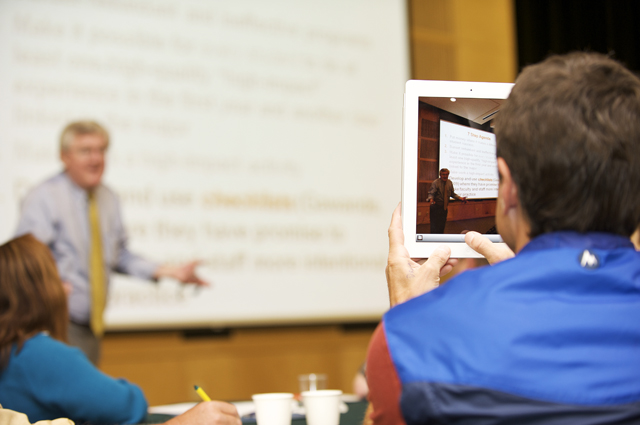
The number of people using mobile devices like tablets instead of personal computers to access the Internet during the first week of the semester jumped from 22 percent to 71 percent between 2010 and 2011, according to recent data compiled by ITS. Fifty percent of those people were iPhone users.
“We’re definitely seeing an increase in the number of people using mobile devices to study, learn and manage their daily schedules,” Enterprise Technology Director Josh Callahan says. “Many people are using an iPhone or an iPad as opposed to the personal computer they were using just a few years ago.”
ITS made mobile device use a lot easier this summer when it unveiled a new way to connect to the campus wireless network. With Safe*Connect, anyone with an HSU user ID and a wireless device that meets university security requirements can quickly hop online. Users can connect to 425 wireless access points across campus, compared to 330 last year.
One downside of improved connectivity is the potential for distraction, which is why ITS suggests that students, faculty and staff stay focused and reduce the amount of time spent surfing the Internet.
But mobile devices like the iPad also have the potential to boost learning and productivity. Leanne Lynch, a student in the Environment and Community MASS, works at the bookstore where she sells iPads and serves on four campus clubs and committees. She uses her iPad2 to respond to emails, download and read class assignments, type notes, record lectures and meetings, take high definition video and manage her calendar.
“How don’t I use my iPad?” says Lynch. “Does it make me muffins? Actually, my friend emailed me a recipe for some muffins and I captured the image of the email to my iPad and read the recipe as I was making the muffins. So yes, it does make muffins.”
Popular iPad applications for learning include Note Taker HD and Noteshelf for taking notes; inClass for recording lectures and iStudiez Pro for scheduling, according to the Center for Excellence in Learning and Technology (CELT), which compiled information about student iPad use. Mobile devices also make it easier for faculty members to schedule appointments and respond to student questions. At a recent CELT discussion on iPad applications, faculty members said they use iPads to display notes, highlight readings and make annotations during class.
According to a recent national study, 78 percent of college students believe that their grades and learning improve with properly implemented technology. The key, students said, was that faculty members know what technology to use and that they actually implement it.
Sioni Martin (’13, Marine Biology) says she appreciates being able to download PDF diagrams for Professor Bruce O’Gara’s Animal Physiology class on her iPad. She uses the tablet to make annotations, read books and use flashcards.
“It’s totally worth it,” Martin says, who also has a laptop she uses less frequently. “As soon as the iPad learns how to type efficiently and works out some of the kinks, I see it being better than a laptop.”